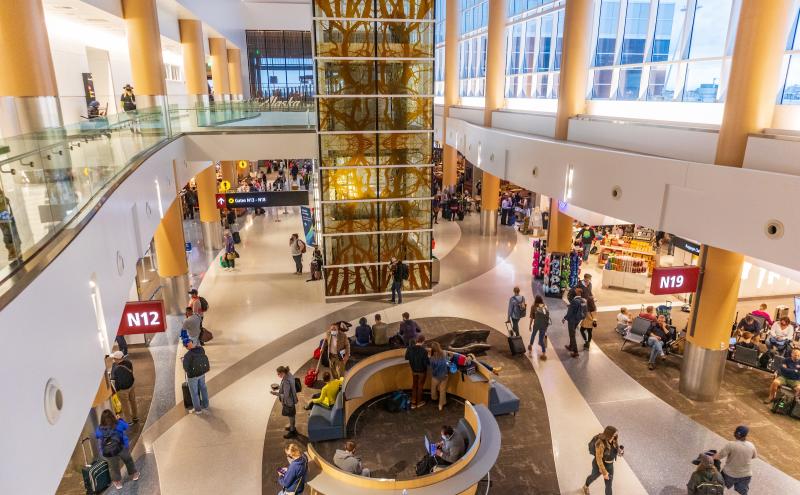
The SEA Airport project team faced a dilemma; how could jets waiting at the gate continue to get fresh air without running their engines? They needed to find a way to protect air quality and conserve fuel. The result: a centralized plant that pumps hot and cold fluids through 15 miles of pipes to each of the airport’s 73 jet gates, where a unit then pre-conditions warm or cool air blown into the aircraft.
The Pre-Conditioned Air Project recently won first place in the 2015 International Tech Awards, sponsored by the American Society of Heating, Refrigerating and Air-Conditioning Engineers (ASHRAE). The Society and its members focus on building systems, energy efficiency, indoor air quality, refrigeration, and sustainability. Each year, the Pre-Conditioned Air System saves about five million gallons in fuel and $15 million in fuel costs. The annual emission reductions equal 40,000 metric tons of greenhouse gases, equivalent to taking 8,000 cars off the road.
“Our region expects this from us,” said project manager Ken Warren. “Our customers and our airlines expect us to do everything we can to protect air quality.”
The success of the project allows aircraft to shut down their auxiliary power units (APUs) while at the gate, improving air quality, reducing noise, increasing energy efficiency, and lowering energy costs for airlines. The project took the top spot in the New Industrial Facilities or Processes category. The project also received the Ralph Robson Technology Award to recognize the best overall winning entry among all the categories in the competition.
“We’re really doing this for the customers by keeping fuel costs and tickets prices down,” said Warren. “And we’re making it more comfortable for passengers waiting onboard aircraft.”
The award acknowledges innovations that other progressive designers would want to look at in hopes of picking up some new ideas. In short, the award recognizes projects that add innovation to good design.
The project also won the regional award in the ASHRAE competition.
More about pre-conditioned air
The Port of Seattle’s Pre-Conditioned Air (PC Air) service heats or cools aircraft during boarding and deplaning to reduce energy costs for airlines, improve air quality, reduce noise, and increase energy efficiency throughout SEA Airport. A centralized plant delivers hot and cold fluids through 15 miles of pipes to each of the airport's 73 jet gates, where a unit then pre-conditions warm or cool air blown into the aircraft. This allows aircraft to shut down their auxiliary power units, which emit CO2 gases and other emissions, and add to airline fuel costs.
Environmental savings
PC Air provides both environmental and financial benefits in keeping with the Port’s Century Agenda goal to reduce the airport’s carbon footprint and increase energy needs through conservation and renewable sources.
Each year, PC Air will save:
- An estimated five million gallons in fuel
- $15 million in fuel costs by the airlines
- 40,000 metric tons of greenhouse gases (carbon dioxide) - the pollution that causes global warming
- 73 tons of nitrogen oxides (NOx) - a nationally regulated air pollutant
Greenhouse gas savings are equivalent to removing 8,000 cars off the road. PC Air also minimizes noise pollution from aircraft parked at the gates.
In addition, SEA obtains about 90 percent of its power from hydro-electric dams and 10 percent from renewable energy and nuclear sources. Both the cooled and heated air generated from PC Air emits substantially less pollution than the petroleum jet fuel in the aircraft’s auxiliary engines.
Central Plant
Over 15 miles of piping installed within the existing terminal connect all of the gates to a system of chillers and heaters to provide the PC Air. The central plant houses four 300-ton chillers that fill 16 ice storage tanks with ethylene-glycol solution cooled by electricity provided by the airport. Four secondary pumps circulate the chilled liquid through pipes to the gates for cooling. Alternately, the airport’s steam plant heats water that is piped to gates for heating. A heat exchanger at the gate directs the conditioned air through a telescoping duct on the jet bridges, to a ventilation hose and directly into the aircraft’s cabin.
The plant is designed with potential airport expansion in mind to manage up to 100 gates in the future.



